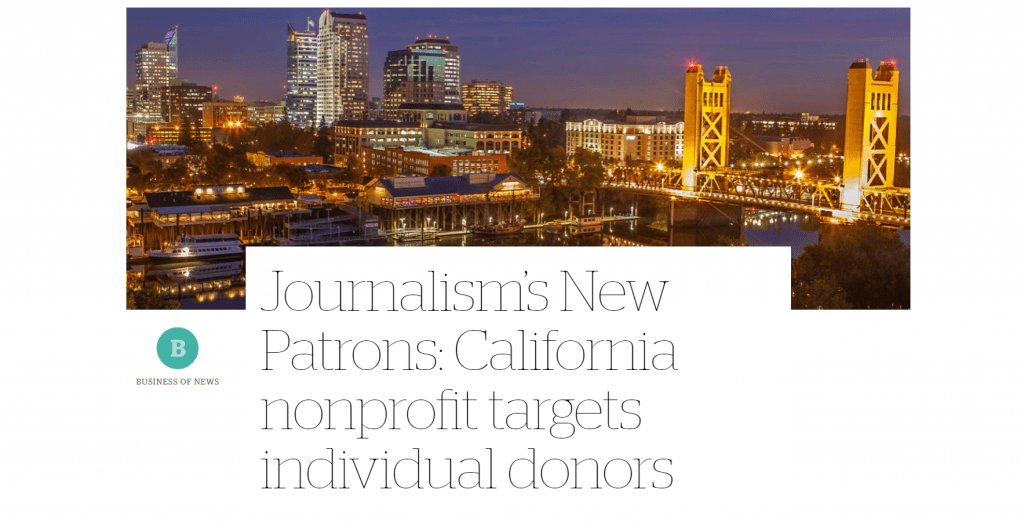Over the past few months, mergers, acquisitions and layoffs — from Time, Inc. selling itself to Meredith Corp. to Gannett cutting back 1 percent of its employees — have rocked the journalism industry, continuing a years-long trend as much of the media world continues to move online. Amid this landscape, a project run by CCLP’s David Westphal aims to explore the possibilities for nonprofit, philanthropy-funded journalism to help local and state news sites stay afloat.
Westphal, a senior fellow at CCLP and an adjunct professor in the Studio 20 digital program at New York University, has spent time interviewing prominent leaders at nonprofit news organizations about the way that they are funded and how they can do the work that they do without relying on a traditional advertising-based revenue model. His research has focused on how wealthy donors can sponsor community journalism, and he aims to help news organizations everywhere understand how nonprofit news can fit into the larger sphere of digital and localized reporting.
The project is part of CCLP’s Future of News initiative, which explores how new models can sustain quality journalism while reaching broader audiences through technological advances. Since its inception in 2007 thanks to a grant from the Carnegie Corporation, this initiative has studied the role of government policy in the news business, as well as the investment of philanthropic foundations and individuals in nonprofit news. CCLP worked with other research centers like the Joan Shorenstein Center on the Press, Politics and Public Policy at the Kennedy School of Government at Harvard to host a roundtable discussion on the topic.
Westphal came to the project with extensive experience in the journalism world, stemming from his work as a newspaper editor and reporter for nearly 40 years. He got his start at The Des Moines Register working as a managing editor before moving on to serve as Washington editor of McClatchy Newspapers. Westphal served as co-chair of the Freedom of Information Committee while the Washington editor at McClatchy. After moving to Los Angeles, he went on to become the executive in residence at USC Annenberg and then editor of the California HealthCare Foundation’s Center for Health Reporting.
The project he now runs at CCLP has a long history, dating back to CCLP Director Geoff Cowan’s push to chronicle the rise of philanthropic funding for the news. Westphal published a paper with Cowan in 2009, titled “Philanthropic Foundations: Growing Funders of the News,” following discussions with three dozen leaders in the field. Since then, CCLP has focused on exploring the individual donor angle, while recognizing that few other research organizations have studied the potential of individual philanthropists to address issues with news funding.
Westphal’s research comes at a time of crisis for many news organizations, as profits are dropping despite many increases in readership — mainly due to the movement of readers to online forms of news, which generate significantly less revenue than print. According to the U.S. Federal Communications Commission, people are paying less these days to support the news that they read, as annual spending on news operations has dropped by $1.6 billion since 2008.
Despite this decrease, many news organizations have seen a rise in subscriptions since the 2016 presidential election, during which — and in the year since — political polarization and the spread of fake news has led many to seek out reliable, established journalism. Nonprofit news organizations have been on the receiving end of much of this newfound enthusiasm for hard-hitting journalism, whether on a national, international, statewide or local scale; The New York Times reported last year that ProPublica, the Center for Public Integrity and the International Consortium of Investigative Journalists all saw sharp increases in donations after the election.
Investment in nonprofit news from larger foundations totals $150 million per year, according to a study by New York University’s Steinhardt School of Culture, Education, and Human Development. But there is little research done so far on how individual philanthropists support news — a gap that Westphal has been trying to close.
In an interview with Simone Coxe, the co-founder, board chair and chief fundraiser for California-based nonprofit news site CalMatters, Westphal asked about the organization’s overall strategy and the difficulties of working with individual donors. Coxe said that convincing people of means to invest in nonprofit news wasn’t difficult if they cared about the issue, and as a result, CalMatters has been able to deliver nonpartisan, hard-hitting reporting about politics and policies across the state.
“We raised $5 million for the first three years, and 90 percent of that was individual money, 10 percent from institutions,” Coxe said. “Of the people giving us $10,000 a year or $25,000 a year, we’re getting something like a 98 percent renewal rate. They bought the idea, they like the execution, and I don’t have any indication they’re going to stop.”
And according to Coxe, the work CalMatters has been doing since it first started up two years ago has already made a difference.
“We have anecdotal evidence that we’ve got legislators behaving differently, citizens are being informed and engaged in ways that they weren’t before, and there’s more dialogue about the issues because of the stuff that we’re doing,” Coxe told Westphal.
